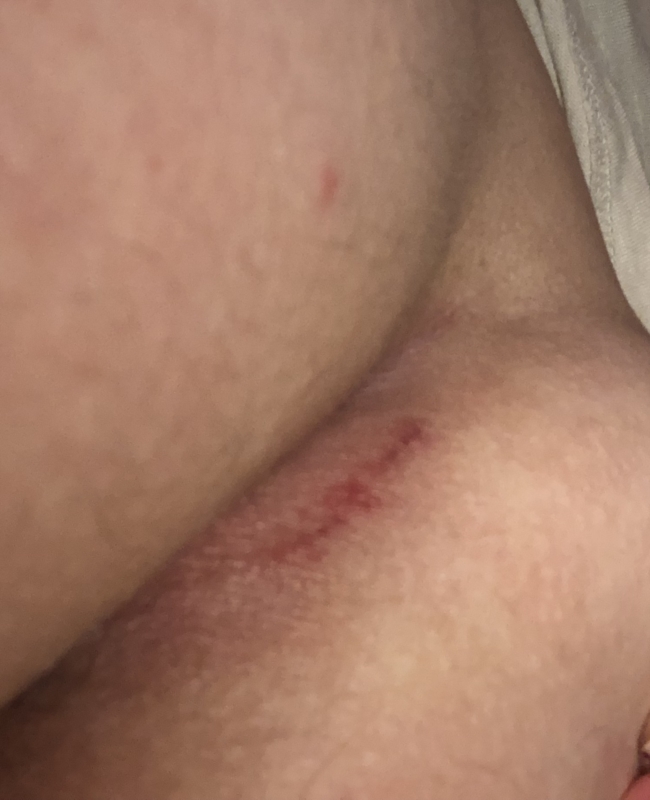A Pilonidal (abscess, cyst, sinus, dimple) is an abscess in the natal cleft (more commonly referred to as your butt crack) that tends to become infected and cause intense pain and drainage. Sometimes a Pilonidal contains hair and sometimes not.
Basic Facts
Between the buttocks; If you have any symptoms of intertrigo, be sure to see your doctor. Your doctor can check for the presence of infection as well. Causes of Intertrigo. Factors like prolonged use of antibiotics, obesity, diabetes, etc. Increase the risk of fungal rash on buttocks, and other areas of the body such as the thighs and groin. Here we discuss the causes of fungal rash and some self-care treatment measures.
- HAIR: The term “Pilonidal” technically means “nest of hairs” and much medical literature is devoted to the idea that hair in the buttock cleft is what causes Pilonidal. This is not always true and approximately 50% of sufferers are found to have no hair in their Pilonidal Abscess (most frequently the case in females.) Hair can play a role in Pilonidal Disease, but the real culprit is an expanded/exploded follicle called a “pit” in the midline of the buttock cleft. A Pilonidal Cyst is basically an abscess beneath the skin – a boil gone very, very bad. Pilonidal abscess are prone to excruciatingly painful infections and they can expand and form additional sinuses.
- CYST: The term “Pilonidal Cyst” is actually incorrect. 99% of all Pilonidals are actually abscesses, not cysts. Pathologists and surgeons on rare occasions find the sac is lined with epidermis, made up of cells from skin, but only cells from the outer layer of skin. That outer layer, which we call epidermis, contains no follicles. Pathologists find epidermis will line the sac only in rare late cases where epidermis has crept into a long-standing abscess in an attempt to heal it. They never find a sac lined with intact skin and follicles, only an occasional sac lined with epidermis. What this means to the patient is that emphasis on surgery to remove the “sac” is incorrect and the focus should be on the root cause of the abscess – the pits in the midline.
- SINUS: While the terms Pilonidal cyst and Pilonidal sinus are frequently used interchangeably, they are not technically the same thing. A Pilonidal is an abscess; a pocket of infection below the skin. A sinus is a cavity/passageway that links the abscess with your outer skin. Not everyone who has a Pilonidal abscess has a Pilonidal sinus; the sinus (and there can be more than one) is a small dimple-like hole, usually below the abscess, which allows it to drain. In extremely aggressive cases it is possible to have 10 or more sinuses.
- LOCATION: Pilonidal abscesses usually occur at the top of the “natal cleft” (aka your butt crack). Their usual position is slightly to the left side, with sinus openings traditionally right along the midline (middle) of the cleft. Many people have abscesses form lower in the cleft or on both sides, it depends on the individual. Severe Pilonidal Disease with multiple tracts/sinuses can extend from the anus all the way to top of the buttock cleft.
- LOCATION 2: The exact placement of a Pilonidal abscess depends on where exactly the pit (which originated the infection) was. As the abscess fills with fluid it presses outward and expands in the path of least resistance. In most cases that path is upward from the infected pit, but it can go in whatever direction gives way first within the tissues.
- LOCATION 3: When the abscess occurs very close to the anus it is more likely to be an Anal Abscess or Anal Fistula, which are different problems than Pilonidal and have different causes/treatments.
- AGE: The peak incidence of Pilonidal Disease is between 16 and 26 (however, older and younger happens regularly too). We have heard from people in their 50’s having their first Pilonidal episode and from parents with children as young as 12. Our experience is that girls see signs earlier at the start of puberty (12 – 14) than boys, who we hear about more in the 16 – 22 age range. It affects males only slightly more than females. It is uncommon (but not unknown) in Asian and Black peoples.
- BABIES: Many babies are born with a “Sacral Dimple”; however, this is not the same as the Pilonidals discussed on this site. Some Sacral Dimples will become infected and turn into Pilonidal abscesses, but most are harmless blind tunnels (which should be checked anyway for possible connections with other problems.)
- TREATING: Pilonidals rarely go away on their own. Most require some form of surgical intervention, although there are cases of “disappearance” after a lancing or antibiotic treatment. Pilonidals can go dormant for years at a time, lulling their owner into a false sense of escape. Every sufferer’s Pilonidal experience is uniquely their own – experiences range from regular flare-ups and constant misery to flare-ups that occur randomly with long gap (sometimes years) in between.
- DEVELOPMENT: Pilonidal abscesses are medically related to a group of diseases known as Follicular Occlusion – meaning blocked hair follicles. At one time it was believed that Pilonidals were all congenital, however, current medical philosophy is that very few of these abscesses are congenital and most are acquired.
Related Links
What is a Pilonidal Cyst / Pilonidal Abscess? Here is where you will find the basic facts of what a Pilonidal is and how they generally tend to form.
How Pilonidals develop in the natal cleft, based on theories and research of Dr. John Bascom. What are the risk factors?
Bleeding From Crack Of Buttocks


Now that you know what a Pilonidal is, you’re probably wondering if that’s what is causing your tailbone pain. Start here, then see a doctor to be sure.
Buttock Crack Infection Pictures
This page last updated: January 2, 2019